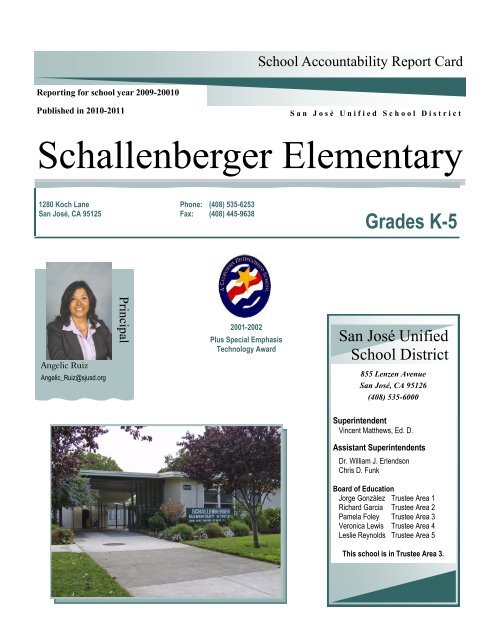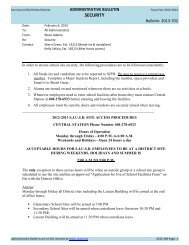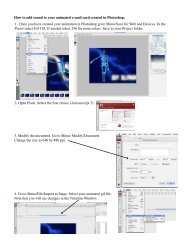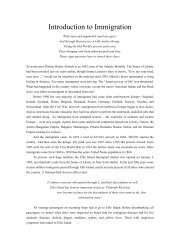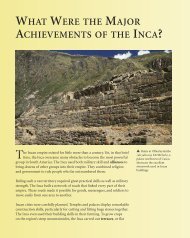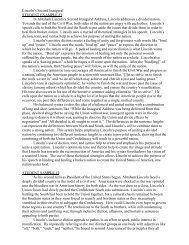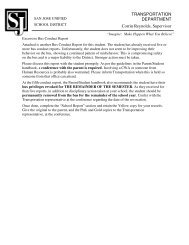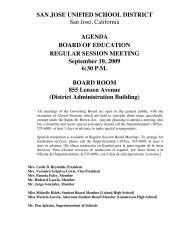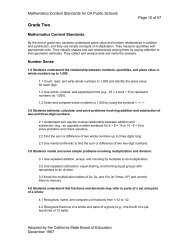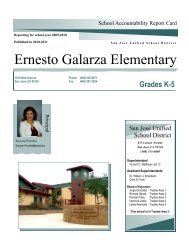Schallenberger Elementary
Schallenberger Elementary
Schallenberger Elementary
You also want an ePaper? Increase the reach of your titles
YUMPU automatically turns print PDFs into web optimized ePapers that Google loves.
Reporting for school year 2009-20010<br />
Angelic Ruiz<br />
Angelic_Ruiz@sjusd.org<br />
Principal<br />
2001-2002<br />
Plus Special Emphasis<br />
Technology Award<br />
School Accountability Report Card<br />
Published in 2010-2011 S a n J o s é U n i f i e d S c h o o l D i s t r i c t<br />
<strong>Schallenberger</strong> <strong>Elementary</strong><br />
1280 Koch Lane<br />
San José, CA 95125<br />
Phone: (408) 535-6253<br />
Fax: (408) 445-9638<br />
Grades K-5<br />
San José Unified<br />
School District<br />
855 Lenzen Avenue<br />
San José, CA 95126<br />
(408) 535-6000<br />
Superintendent<br />
Vincent Matthews, Ed. D.<br />
Assistant Superintendents<br />
Dr. William J. Erlendson<br />
Chris D. Funk<br />
Board of Education<br />
Jorge Gonzàlez Trustee Area 1<br />
Richard Garcia Trustee Area 2<br />
Pamela Foley Trustee Area 3<br />
Veronica Lewis Trustee Area 4<br />
Leslie Reynolds Trustee Area 5<br />
This school is in Trustee Area 3.
<strong>Schallenberger</strong> <strong>Elementary</strong><br />
School Profile<br />
<strong>Schallenberger</strong> is a California Distinguished School. There is a strong<br />
emphasis on meeting and exceeding State standards, utilizing technology for<br />
teaching and learning and modeling Life Long Learning standards. Twenty-two<br />
classroom teachers work for the success of approximately 575 students.<br />
Accelerated Reader and Accelerated Math programs are integral components<br />
of the school curriculum providing leveled practice of essential skills. Teachers<br />
provide interventions for struggling students both during the school day as well<br />
as after school. Opportunities to extend learning are provided through<br />
differentiated instruction in the classroom. Students have many opportunities<br />
to receive recognition for goals accomplished. Monthly award assemblies are<br />
held to promote WISE behavior and self-esteem. Parents work seamlessly as<br />
volunteers and school leaders to enrich the learning environment.<br />
Principal’s Experience<br />
This is Angelic Ruiz’s fourth year at <strong>Schallenberger</strong> <strong>Elementary</strong>. She brings administrative experience from Galarza/Hammer, Anne Darling,<br />
and Terrell <strong>Elementary</strong>. Her experience as a district resource teacher prepared her for leadership. Angelic uses her classroom and<br />
administrative experience to promote student achievement and a positive school culture.<br />
Major Achievements<br />
API of 845 (1 point gain in 2010)<br />
California Distinguished School designation in May, 2002<br />
Accelerated Reader K-5 and Accelerated Math in grades 2-5<br />
Three Accelerated Reader Model / Master Classrooms in 2009<br />
Expanded Homework Club provided by teachers<br />
Music enrichment program<br />
Incentive rewards for academic progress and service to the school<br />
Staff working in collaborative grade level teams to use student work and student data to plan their instruction<br />
Implementation of best classroom practices across the curriculum<br />
Additional Instructional support for all classrooms<br />
Student technology standards integrated into curriculum K-5<br />
Parental Involvement<br />
Our vision is:<br />
“<strong>Schallenberger</strong> is a nurturing<br />
environment where teachers and staff use<br />
effective instructional strategies to teach<br />
students the skills necessary to<br />
communicate effectively, problem solve,<br />
explore, and create while becoming selfassured,<br />
productive, responsible, lifelong<br />
learners who will succeed in an everchanging<br />
world.”<br />
Parents are encouraged to participate in all school functions such as Kinder Orientation, Back-to-School Night, Open House, Home & School<br />
Association meetings, School Site Council meetings, Principal’s Coffee, Site English Learner Advisory Committee and GATE Committees.<br />
Translation into Spanish is provided during meetings. We keep parents informed through a bimonthly school newsletter called The Parent<br />
Update. Email, phone messages and school website provides updated information and news about curriculum and instruction, as well as<br />
classroom and school activities. The <strong>Schallenberger</strong> Home and School Association (SHSA) maintains a database of parents’ email addresses<br />
and notifies parents of upcoming events. SHSA helps coordinate parent volunteers in classrooms, Media Center, Art Vista docents, Project<br />
Cornerstone ABC Parents, provide Junior Achievement lessons, lunchtime activities and support Home and School Association fundraisers/<br />
activities.<br />
For further information on parent volunteer program, please contact the school office or Home and School Association.<br />
► 2
<strong>Schallenberger</strong> <strong>Elementary</strong><br />
Demographics<br />
The chart and table below show the number of students enrolled in each grade level and the percent of students enrolled who are identified as<br />
being in a particular group during the 2008-2009 school year.<br />
Number of students at the Grade<br />
Level<br />
95<br />
Class Size<br />
Total students: 574<br />
103 101<br />
84<br />
91<br />
Average Class Size and Class Size Distribution<br />
2007-2008 2008-2009 2009-10<br />
Grade<br />
Avg.<br />
Class<br />
Size<br />
Number of Classrooms<br />
1-20 21-32 33+<br />
Avg.<br />
Class<br />
Size<br />
Number of Classrooms<br />
1-20 21-32 33+<br />
Avg.<br />
Class<br />
Size<br />
Number of Classrooms<br />
1-20 21-32 33+<br />
K 19.6 5 20.0 5 27.0 3<br />
1 20.0 4 19.8 5 28.3 3<br />
2 20.3 3 19.0 3 29.0 3<br />
3 30.0 3 29.5 2 30.0 2<br />
4 30.5 2 31.0 2 29.0 3<br />
5<br />
6<br />
30.5 2 31.0 2 31.0 3<br />
K-3 20.0 1 19.5 2 23.0 1 2<br />
3-4 30.0 1 13.0 1<br />
4-8<br />
Other<br />
31.0 1 31.0 1<br />
100<br />
K 1st 2nd 3rd 4th 5th<br />
This table displays by grade level the average class size and the number of classrooms<br />
that fall into each size category (a range of total students per classroom).<br />
Student Enrollment by group<br />
African American 4.53 %<br />
American Indian or Alaska Native 0.52 %<br />
Asian 7.49 %<br />
Filipino 2.09 %<br />
Hispanic or Latino 37.46 %<br />
Pacific Islander 0 %<br />
White (Not Hispanic) 43.09 %<br />
Multiple or No Response %<br />
Socioeconomically disadvantaged 36.00 %<br />
English Learners 15.00 %<br />
Students with disabilities 11.00 %<br />
► 3
<strong>Schallenberger</strong> <strong>Elementary</strong><br />
Climate for Learning<br />
Safety<br />
The Site Safety Plan is reviewed every year. Key elements are: the Cornerstone Project, SST Process, Counseling, use of student awards and<br />
certificates, staff training, following the Student and Parent Handbook, noon activities, use of the communication systems in each room,<br />
monitoring of the site for strangers, practicing of the emergency drills, accounting for volunteers and visitors, zero tolerance, communication<br />
with parents via the Parent Update and e-mail messages, notifying teachers when a student is suspended, etc.<br />
Staff monitors school grounds 30 minutes before school starts and immediately after dismissal. Students leaving classes go in twos. Adult and<br />
student safety patrol members cross children coming to and leaving school and greet them at the drop-off area in the parking lot. A shed<br />
contains emergency supplies that are continuously updated.<br />
Besides the Site Safety Plan, the site Emergency Plan is reviewed and updated every year. Practice drills are held monthly for fire and<br />
quarterly for disasters.<br />
Homework<br />
Homework is assigned according to the District’s policy Monday – Thursday. It is also expected that in addition to regular homework, all<br />
students read at least 15-30 minutes each night according to their grade level.<br />
Discipline<br />
This year we adopted the Positive Behavior<br />
Intervention Support (PBIS) program to improve our<br />
school climate. The PBIS program provides a clear<br />
set of behavior expectations. We are respectful, I<br />
Care, Safety Matters and Everyone is responsible<br />
(WISE) is the slogan that summarizes the behavior<br />
expectations for the classroom, eating area, media<br />
center, bathrooms and outdoors. To encourage<br />
students to be WISE, we have developed a reward<br />
and monitoring system for each of the areas. A<br />
progressive discipline flow chart was developed to<br />
illustrate our process to guide behavior modification.<br />
Suspensions and Expulsions—3 year comparison<br />
School District<br />
2007-08 2008-09 2009-10 2007-08 2008-09 2009-10<br />
Rate of Suspensions 5.7% 5.1% 1.22% 13.6% 11.8% 5.17%<br />
Rate of Expulsions 0.0% 0.0% 0.0% 0.2% 0.2% 0.19%<br />
In addition we have ABC parents from the Cornerstone Project. Parent volunteers read, discuss and plan activities to reinforce LIFESKILLS.<br />
Our counselors work with individual and small groups to build self-esteem. Varieties of activities are offered during lunchtime to give students<br />
positive options.<br />
► 4<br />
This table displays the rate of suspensions and expulsions (total number of incidents divided<br />
by the total enrollment) at the school and district levels for the most recent three-year period.
<strong>Schallenberger</strong> <strong>Elementary</strong><br />
Facilities<br />
<strong>Schallenberger</strong> was built in 1955 and modernized from 1998-2000 with Measure C bond money. New playground equipment for the main<br />
playground was installed in 1995 and in 2004 was relocated with a rubber mat under the equipment and brought up to code. The kindergarten<br />
play equipment was installed in 1999 and in 2005, a rubber mat was also installed under the equipment. In 2002-2003, parents, staff, and<br />
community renovated the memorial/reflective area at the corner of Koch Lane and Gerald Way that is named Meredith’s Corner in memory of a<br />
former student. A new building that houses the library, computer lab, bathrooms, and eight classrooms was built during the 2004-2005 school<br />
year with Measure F bond money. In addition to the building of a new building, the following were accomplished during the 2004-2005 school<br />
year:<br />
The traditional classrooms (#1-16) were modernized with new sinks, cabinets, and windows.<br />
New portables were relocated and upgraded.<br />
Bathrooms (student and staff) were modernized and brought up to code<br />
This table displays the results of the most recently completed school site inspection to determine the school facility’s good repair<br />
status. Each area/classroom of the school is inspected. A “deficiency” is counted for each occurrence of a condition. Descriptions of<br />
similar deficiencies are combined rather than to list by classroom.<br />
System Inspected Exemplary Good Fair Poor<br />
Systems: Gas Leaks, Mechanical/HVAC, Sewer <br />
Interior: Interior Surfaces <br />
Cleanliness: Overall Cleanliness, Pest/ Vermin<br />
Infestation<br />
Electrical: Electrical <br />
Restrooms/Fountains: Restrooms, Sinks/<br />
Fountains<br />
Safety: Fire Safety, Hazardous Materials <br />
Structural: Structural Damage, Roofs <br />
External: Playground/School Grounds, Windows/<br />
Doors/Gates/Fences<br />
Overall Summary of School Facility Good Repair Status as of August 25, 2010.<br />
Facility Condition Exemplary Good Fair Poor<br />
<br />
<br />
<br />
<br />
Repair needed and action taken or<br />
planned<br />
► 5<br />
There were 4 deficiencies in this area.<br />
They were all for dirty AC/Heating vents.<br />
There were 7 deficiencies in this area. A<br />
wall that has cracks, broken tile, wall<br />
chipped, carpet tearing, hole in wall, and<br />
a wall under white board needs paint.<br />
There was 1 deficiency in this area.<br />
Leaves in Kinder playground need to be<br />
blown out .<br />
There were 5 deficiencies in this area.<br />
They were for the need to replace<br />
burned out light bulbs or repair entire<br />
banks of lights and an outlet loose in<br />
Rm 29.<br />
There were 2 deficiencies in this area.<br />
Drinking fountain broken in K-2 and<br />
soap disposable empty in Rm 21.<br />
There were 2 deficiencies in this area.<br />
Plug missing on double slide right side<br />
in Kinder playground and plugs missing<br />
on slides in main playground.<br />
There were 2 deficiencies in this area.<br />
Door to storage room needs paint in Rm<br />
9 and Rm 6.
<strong>Schallenberger</strong> <strong>Elementary</strong><br />
Teacher and Staff Information<br />
Teacher Credentials<br />
26 Teachers<br />
School District<br />
2007-08 2008-09 2009-10 2009-10<br />
With Full Credential 26 26 22 1360<br />
Without Full Credential 1 1 0<br />
59<br />
Teaching Outside Subject Area of Competence 0 0 0<br />
2<br />
This table displays the number of teachers assigned to the school with a full credential,<br />
without a full credential, and those teaching outside of their subject area of competence.<br />
Teacher Misassignments and Vacant Teacher Positions<br />
Indicator 2007-2008 2008-2009 2009-2010<br />
Misassignments of Teachers of English Learners 0 0 0<br />
Total Teacher Misassignments 0 0 0<br />
Vacant Teacher Positions 0 0 0<br />
Teacher misassignments (teachers assigned without proper legal authorization)<br />
Note: Total Teacher Misassignments includes the number of Misassignments of<br />
Teachers of English Learners.<br />
Vacant teacher positions (not filled by a single designated teacher assigned to teach the entire<br />
course at the beginning of the school year or semester).<br />
Core Academic Classes Taught by NCLB Compliant<br />
Teachers<br />
This School<br />
All Schools in District<br />
High Poverty Schools<br />
Low Poverty Schools<br />
98.3%<br />
99.1%<br />
99.2%<br />
100.0%<br />
Detailed information<br />
about teacher<br />
qualifications can be<br />
found at the CDE Web<br />
site at<br />
http://dq.cde.ca.gov/<br />
dataquest/.<br />
► 6<br />
The No Child Left Behind Act (NCLB) requires that all teachers<br />
teaching in core academic subjects are to be "highly qualified".<br />
In general, NCLB requires that each teacher must have:<br />
A bachelor's degree<br />
A state credential or an Intern Certificate/Credential for no<br />
more than three years<br />
Demonstrated subject matter competence for each core subject<br />
to be taught by the teacher.<br />
This is chart displays the percent of classes in core academic<br />
classes taught by No Child Left Behind (NCLB) compliant<br />
teachers in the following areas:<br />
Teachers at this school<br />
Teachers in the District<br />
High poverty schools (student participation of 75% or more in<br />
free and reduced meals program)<br />
Low poverty schools (student participation of 25% or less in the<br />
free and reduced meals program)<br />
More information on teacher qualifications required under<br />
NCLB can be found at the California Department of Education's<br />
Web site at http://www.cde.ca.gov/nclb/sr/tq/.
<strong>Schallenberger</strong> <strong>Elementary</strong><br />
The office (main office, workroom, and health office) was modernized and brought up to code.<br />
The field was renovated and a decomposed granite walkway was installed around its perimeter.<br />
The playground was resealed and games were repainted.<br />
The kitchen was modernized and a new speed line was installed.<br />
The stage was resurfaced.<br />
Grounds are kept clean and safe by our excellent custodian and with the support of students, staff, and parent volunteers. The school<br />
community continues to improve the physical environment with a beautification program supported by the Home and School Association. In<br />
2006, this parent organization purchased 15 new picnic tables for outdoor eating.<br />
Evaluating/Improving Teachers<br />
Teacher evaluation is based on the implementation of standards-based instruction according to the District’s pacing calendars for English<br />
Language Arts, Mathematics, and English Language Development. <strong>Schallenberger</strong>’s staff is rich with master teachers who volunteer to mentor<br />
new teachers both on staff and in student teaching. Staff has targeted specific focus areas for improvement during the school year both<br />
collectively, as grade levels, and individually. In addition to formal evaluation, each teacher meets with the principal twice a year to review<br />
individual teaching goals and progress toward meeting these goals. Formal evaluation occurs every year for temporary teachers and every two<br />
years for probationary and permanent teachers. After 10 years of successful teaching, teachers may request a five-year evaluation cycle<br />
according to their contract with the district, and at the discretion of the principal.<br />
Professional Development<br />
This year our staff development is focused on Direct Instruction to close the achievement gap. Professional development is delivered at district<br />
trainings, staff meetings, BTSA mentoring, workshops, and during classroom demonstrations. Teachers also receive instructional support<br />
through in-class coaching sessions, one-on-one sessions with the principal, grade level meetings, and visits to the classrooms of colleagues.<br />
Substitute Teachers<br />
<strong>Schallenberger</strong> is fortunate to have a pool of substitute teachers comprised of current/former parents and retired teachers who choose to<br />
substitute at <strong>Schallenberger</strong>.<br />
Support Staff<br />
<strong>Schallenberger</strong> has 1.0 FTE speech/language/hearing specialist..<br />
► 7
<strong>Schallenberger</strong> <strong>Elementary</strong><br />
Curriculum<br />
Reading and Writing<br />
Houghton-Mifflin Reading/Language Arts curriculum is aligned to State Standards. Specific trade books are designated as Core Literature.<br />
Teachers supplement the core program with additional fiction and nonfiction books (all approved by the Board of Education). Power Reading<br />
lessons for Accelerated Reading are used to supplement reading comprehension lessons. Individual student spelling surveys administered<br />
several times each year identify spelling skills mastered and still needed. Step Up to Writing is used as a foundation for organizing writing<br />
across the grades and in various genres. STAR Early Literacy and STAR Reading tests, administered at least 4 times a year, measure skills<br />
mastered and determine appropriate independent and classroom instruction levels. Benchmark tests are also administered in English<br />
Language Arts three times/year. Results are used to monitor progress and identify skill areas where additional instruction is needed.<br />
Math<br />
Scott Foresman Envision Math is aligned to State Standards and is the base program. It is a balanced program with opportunities for concept<br />
development, problem solving, practice, and extension and test practice. Skills are cycled through the year’s lessons. Mathematics instruction<br />
is supplemented with Accelerated Math in grades 2-5. AM objective libraries span first grade through Algebra to meet the needs of all students.<br />
The STAR math assessment, given 4 times a year, helps the staff place students at the appropriate learning level. All primary classrooms have<br />
ample sets of manipulatives to assist with concept development. Benchmark tests are also administered in Mathematics three times/year.<br />
Results are used to monitor progress and identify skill areas where additional instruction is needed.<br />
Science<br />
Scott-Foresman is aligned to meet State Standards. FOSS hands-on kits are used to supplement science units by providing hands on learning.<br />
Field trips and assemblies extend the science curriculum. The library contains a rich assortment of books and videos, aligned to the District<br />
grade level standards, and selected to supplement the grade level curriculum.<br />
Social Studies<br />
Macmillan/McGraw Hill Studies is aligned to<br />
State Standards and was used as our base<br />
program. Supplementary materials, use of<br />
Internet resources, assembly presentations,<br />
and aligned literature amplify the curriculum.<br />
Fifth graders participate in the Law Related<br />
Education course as part of the social studies<br />
curriculum.<br />
English Language Development<br />
Avenues from Hampton Brown in grades K-3<br />
as the base program for ELD. Houghton<br />
Mifflin’s support materials are used for ELD<br />
instruction in grades 4-5.<br />
Textbooks<br />
All District-adopted texts are aligned to State<br />
Standards. All texts meet state standards,<br />
and all tests and supplementary materials<br />
have been adopted by our Board of<br />
Education. Language Arts/Reading textbooks<br />
were adopted in 2003. Mathematics<br />
textbooks were adopted in 2009. Science<br />
textbooks were adopted in 2008. Social<br />
Studies textbooks were adopted in 2007.<br />
QUALITY, CURRENCY, AND AVAILABILITY OF TEXTBOOKS AND<br />
INSTRUCTIONAL MATERIALS<br />
Reading/<br />
Language Arts<br />
Percent of Pupils Who<br />
Lack Their Own Assigned<br />
Textbooks<br />
and/or Instructional<br />
Materials<br />
Most Recent SBE or Local<br />
Governing Agency Approved<br />
Textbooks and Instructional<br />
Materials<br />
0% No<br />
Mathematics 0% Yes<br />
Foreign Language 0% Yes<br />
Science 0% Yes<br />
History-Social<br />
Science<br />
Health 0%<br />
Science Laboratory<br />
Equipment<br />
(grade 9-12)<br />
0% Yes<br />
K-5 Yes<br />
6-8 No<br />
0% Yes<br />
A list of textbooks and adoption dates is available at:<br />
http://www.sjusd.org/schools/documentation/downloads/Textbook_listing.pdf<br />
► 8
<strong>Schallenberger</strong> <strong>Elementary</strong><br />
Each student has access to one text per subject. All adopted texts are current. Textbooks that are no longer usable are replaced annually.<br />
Teachers identify needed support resource materials each fall and these are purchased using site funds.<br />
Specialized Programs<br />
GATE<br />
All teachers are trained in and implement differentiated teaching strategies in the classroom. Accelerated Reading and Accelerated Math are<br />
open-ended programs identified as extending the curriculum. Student achievement is monitored using District reports for the GATE subgroup.<br />
Special Ed<br />
The Resource Specialist coordinates the Special Education services at <strong>Schallenberger</strong> and instructs up to 28 students according to their<br />
Individualized Learning Plans. The Speech and Language Pathologist provides therapy for up to 55 students. <strong>Schallenberger</strong> also has a<br />
Special Handicapped Class in K-2. The progress of students receiving Special Education services is monitored through the IEP process.<br />
At-risk students<br />
At-risk students are identified according to state and school test results. Students receive differentiated instruction in leveled or small groups by<br />
a certificated teacher. Language! curriculum and instruction is provided for all 4 th – 5 th grade at risk of retention during the school day. Voyager<br />
extended day is offered for targeted students in grades 1 st through 5 th. Teachers meet in grade level teams and use Benchmark data,<br />
curriculum embedded tests and work samples, monitor student progress monthly.<br />
The Student Study Team process is used to develop an action plan to help students who are having difficulties with academics, behavior, or<br />
attendance. When students continue to have academic difficulties, they are referred for review. Subsequent testing is used to identify special<br />
education eligibility and services. <strong>Schallenberger</strong> provides Speech and Language therapy, the Resource Specialist Program, and a Special<br />
Day Class for students eligible for special education services.<br />
Students with disabilities or conditions that affect a major life activity who do not qualify for services from Special Education are considered for<br />
accommodations under a 504 Plan. The 504 team makes this determination and, if appropriate, designates the most important<br />
accommodations necessary for student success. These are written into the student’s 504 Plan.<br />
English language learners<br />
English Language Learners are identified upon enrollment and are assessed using the California English Language Development Test<br />
(CELDT). The CELDT has five levels of proficiency. The levels range from 1-5 with Level 1 representing the beginning level of English<br />
proficiency and Level 5 representing the advanced level of proficiency. Each grade level team develops a plan for the instruction of ELD and<br />
instructional support for EL students. Students with CELDT Level 1 -3 receive ELD instruction using Avenues curriculum. Students with<br />
CELDT levels of 3,4 and 5 receive embedded ELD in content, during English Language Arts, Science, Social Studies and Math. Teachers use<br />
Frontloading, Universal Access, Think-Pair-Share, Body Kinesthetic, Reciprocal Teaching, Quick Writes, Supportive Questioning and other<br />
scaffolding strategies to maximize ELD learning.<br />
English Language Learners are monitored through CELDT scores, benchmark tests, theme curriculum based-assessments, CST, student work<br />
and other measures of student performance. Once an English Learner has met proficiency levels in assessment areas, especially CST and<br />
classroom performance, he/she becomes a candidates for reclassification. Students who are reclassified are monitored for three years. In the<br />
first year, reclassified students are evaluated three times to make sure they are progressing satisfactorily. In the second and third year,<br />
students are evaluated once. If students have not progressed satisfactorily, it is recommended the instructional program be adjusted or<br />
interventions be implemented.<br />
Students with disabilities<br />
The Student Study Team process is used to develop an action plan to help students who are having difficulties with academics, behavior, or<br />
attendance. When students continue to have academic difficulties, they are referred for review. Subsequent testing is used to identify special<br />
education eligibility and services. <strong>Schallenberger</strong> provides Speech and Language therapy, the Resource Specialist Program, and two Special<br />
Day Classes for students eligible for special education services.<br />
► 9
<strong>Schallenberger</strong> <strong>Elementary</strong><br />
School Finances (Fiscal Year 2008-2009)<br />
Expenditures Per Pupil and School Site Teacher Salaries<br />
Level<br />
Types of Services Funded<br />
Total Expenditures<br />
per Pupil<br />
Restricted<br />
(supplemental)<br />
expenditures per<br />
Unrestricted<br />
(basic)<br />
expenditures<br />
Average Teacher<br />
Salary<br />
School Site 9,172.10 3,891.73 5,280.38 66,168.63<br />
District 9,302.70 4,038.27 5,264.43 66,170.00<br />
Percent Difference - School Site and District -1.40% -3.63% 0.30% 0.00%<br />
State<br />
5,681.00 68,170.00<br />
Percent Different - School Site and State -7.05% -2.94%<br />
This table displays a comparison of the school's per pupil expenditures from unrestricted (basic) sources with other<br />
schools in the district and throughout the state, and a comparison of the average teacher salary at the school site with<br />
average teacher salaries at the district and state levels. Detailed information regarding school expenditures can be found<br />
at the Current Expense of Education Web page at http://www.cde.ca.gov/ds/fd/ec/ and teacher salaries can be found on<br />
San José Unified School District spent an average of $9,303 per student in the 2008-09 school year, compared to $8,825 per student<br />
spent on average by all unified districts in the state. Total operating expenses for the 2007-08 year were $279,871,911. Additional details<br />
about San José Unified’s expenditures can be found on the Ed-Data web site (www.ed-data.k12.ca.us).<br />
These expenses are for costs related to educational services to students as well as directly related support costs, such as utilities, custodial<br />
and maintenance costs. Included also are central support costs related to such activities as hiring, purchasing and accounting. This<br />
figure does not include food services, land acquisition, new construction, and other expenditures unrelated to core educational purposes.<br />
The expenses-per-student figure is calculated by dividing total expenses by the district’s average daily attendance (ADA).<br />
Comparison of District and State Teacher and Administrative Salaries (Fiscal Year 2008-09)<br />
This table displays district-level salary information for teachers, principals, and superintendents, and compares these figures to the state<br />
averages for districts of the same type and size. The table also displays teacher and administrative salaries as a percent of a district's<br />
budget, and compares these figures to the state averages for districts of the same type and size. Detailed information regarding salaries<br />
may be found on the Certificates Salaries and Benefits Web page at http://www.cde.ca.gov/ds/fd/cs/.<br />
Category<br />
District<br />
Amount<br />
State Average<br />
For Districts<br />
In Same Category<br />
Beginning Teacher Salary $42,969 $42,377<br />
Mid-Range Teacher Salary $71,000 $67,667<br />
Highest Teacher Salary $86,290 $87,102<br />
Average Principal Salary (<strong>Elementary</strong>) $106,935 $108,894<br />
Average Principal Salary (Middle) $111,600 $113,713<br />
Average Principal Salary (High) $134,522 $124,531<br />
Superintendent Salary $245,309 $223,323<br />
Percent of Budget for Teacher Salaries 37.10 % 40.20 %<br />
Percent of Budget for Administrative Salaries 5.40 % 5.50 %<br />
► 10
<strong>Schallenberger</strong> <strong>Elementary</strong><br />
Student Performance<br />
Standardized Testing and Reporting Program<br />
The Standardized Testing and Reporting (STAR) Program consists of several key components,<br />
including the California Standards Tests (CSTs); the California Modified Assessment<br />
(CMA), and the California Alternate Performance Assessment (CAPA).<br />
The California Standards Tests (CST) show how well students are doing in relation to the<br />
State content standards and are reported as performance levels. Students are tested in the<br />
following areas:<br />
English and Language Arts—Grades 2-11<br />
Mathematics—Grades 2—11<br />
Science—Grades 5, 8, 9, 10 and 11<br />
History and Social Science—Grades 8, 10 and 11<br />
The CAPA and CMA are alternative assessments for special education students with Individual<br />
Educational Plans.<br />
Detailed information regarding the STAR Program results for each grade and performance level, including the percent of students not tested,<br />
can be found on the CDE Standardized Testing and Reporting (STAR) Results Web site at http://star.cde.ca.gov. Program information regarding<br />
the STAR Program can be found at http://starsamplequestions.org/welcome.html<br />
Subject<br />
NOTE: Scores are not shown<br />
when the number of students<br />
tested is ten or less, either<br />
because the number of students in<br />
this category is too small for<br />
statistical accuracy or to protect<br />
student privacy. In no case shall<br />
any group score be reported that<br />
would deliberately or inadvertently<br />
make public the score or<br />
performance of any individual<br />
student.<br />
California Standards Test (CST) All Students—Three-Year Comparison<br />
Percent of students achieving at the proficient or advanced level<br />
School District State<br />
2007-08 2008-09 2009-10 2007-08 2008-09 2009-10 2007-08 2008-09 2009-10<br />
English-Language Arts 57 64 65 51 54 56 46 50 52<br />
Mathematics 68 72 63 48 50 51 43 46 48<br />
Science 56 51 70 50 52 57 46 50 54<br />
► 11
<strong>Schallenberger</strong> <strong>Elementary</strong><br />
California Standards Test (CST) by Student Group—Most Recent Year<br />
Percent of students at the proficient or advanced level<br />
Group English-Language Arts Mathematics Science History-Social<br />
Science<br />
All Students in the LEA 57 52 57 50<br />
All Students at the School 65 63 67<br />
Male 62 62 67<br />
Female 69 64 69<br />
African American 78 78 *<br />
American Indian or Alaska Native * *<br />
Asian 83 90<br />
Filipino * * *<br />
Hispanic or Latino 48 43 59<br />
Native Hawaiian or Pacific Islander * *<br />
White (not Hispanic) 73 47 68<br />
Two or More Races<br />
Socioeconomically Disadvantaged 49 43 56<br />
English Learners 30 36<br />
Students with Disabilities 38 20<br />
Students Receiving Migrant Education Services * * *<br />
► 12
<strong>Schallenberger</strong> <strong>Elementary</strong><br />
Academic Performance Index (API)<br />
The Academic Performance Index (API) is an annual measure of the academic performance and progress of schools in California. API<br />
scores range from 200 to 1,000 with a statewide target of 800. Detailed information about the API can be found at the CDE API Web Page at<br />
http://www.cde.ca.gov/ta/ac/ap/<br />
API Ranks<br />
This table displays the school’s similar schools API ranks. These<br />
API Rank 2007 2008 2009<br />
ranks are published when the Base API is released each March.<br />
The statewide API rank ranges from 1 to 10. A statewide rank of 1 Statewide 8 8 8<br />
means that the school has an API score in the lowest 10% of all Similar Schools 6 5 5<br />
schools in the state, while a statewide rank of 10 means that the<br />
school has an API score in the highest 10% of all schools in the state. The similar schools API rank reflects how a school compares to 100<br />
statistically matched ―similar schools.‖ A similar schools rank of 1 means that the school’s academic performance is comparable to the lowest<br />
performing 10 schools of the 100 similar schools, while a similar schools rank of 10 means that the school’s academic performance is better<br />
than at least 90 of the 100 similar schools.<br />
API Changes by Student Group -- Three Year Comparison<br />
This table displays, by student group, the actual API changes in points added or lost for the past three years, and the most recent API score.<br />
Note: "N/A" means that the student group is not numerically significant.<br />
Actual API Change Growth API Score<br />
2007-08 2008-09 2009-10<br />
2010<br />
All students at this school 16 20 1<br />
845<br />
Hispanic or Latino 3 17 -23<br />
768<br />
White (Not Hispanic) 33 10 11<br />
891<br />
Socioeconomically disadvantaged 11 7 6<br />
767<br />
English Learners -3 -11 30<br />
753<br />
Students with Disabilities<br />
Adequate Yearly Progress (AYP)<br />
The federal NCLB act requires that all schools and districts<br />
meet the following Adequate Yearly Progress (AYP)<br />
criteria:<br />
Participation rate on the state's standards-based<br />
assessments in English-language arts (ELA) and<br />
mathematics<br />
Percent proficient on the state's standards-based<br />
assessments in ELA and mathematics<br />
API as an additional indicator<br />
Graduation rate (for secondary schools)<br />
Detailed information about AYP, including participation<br />
rates and percent proficient results by student group, can<br />
be found at the CDE AYP Web page at<br />
http://www.cde.ca.gov/ta/ac/ay/.<br />
AYP Criteria School District<br />
Overall Yes No<br />
Participation Rate - English-Language Arts Yes Yes<br />
Participation Rate - Mathematics Yes Yes<br />
Percent Proficient - English-Language Arts Yes No<br />
Percent Proficient - Mathematics Yes No<br />
API Yes Yes<br />
Graduation Rate N/A Pend<br />
► 13<br />
This table displays an indication of whether the school and the district made<br />
AYP overall and whether the school and the district met each of the AYP<br />
criteria.
<strong>Schallenberger</strong> <strong>Elementary</strong><br />
Federal Intervention Program (School Year 2009-10)<br />
Indicator School District<br />
Program Improvement Status Not in PI In PI<br />
First Year of Program Improvement Implementation 2009-2010<br />
Year in Program Improvement Year 2<br />
Number of Schools Currently in Program Improvement N/A 13<br />
Percent of Schools Currently in Program Improvement N/A 25<br />
Detailed information about PI identification can be found at the CDE AYP Web<br />
page at http://www.cde.ca.gov/ta/ac/ay/.<br />
California Physical Fitness Test<br />
Grade Level<br />
San José Unified School District<br />
► 14<br />
Schools and districts receiving federal Title I<br />
funding enter Program Improvement (PI) if they<br />
do not make AYP for two consecutive years in<br />
the same content area (English-language arts or<br />
mathematics) or on the same indicator (API or<br />
graduation rate). After entering PI, schools and<br />
districts advance to the next level of intervention<br />
with each additional year that they do not make<br />
AYP.<br />
The School Accountability Report Card (SARC), which is required by law to be published annually, contains information about the condition and<br />
performance of each California public school. More information about SARC requirements is available on the SARC Web page at http://<br />
www.cde.ca.gov/ta/ac/sa/. For additional information about the school, parents and community members should contact the school principal or<br />
the district office.<br />
Data and Access<br />
DataQuest<br />
San José Unified’s SARCs are prepared by the Office of Educational Accountability<br />
(408) 535-6194 ▼ Fax (408) 535-2308<br />
http://www.sjusd.org<br />
DataQuest is an online data tool located at http://dq.cde.ca.gov/dataquest/ that contains additional information about this school and comparisons<br />
of the school to the district, the county, and the state. Specifically, DataQuest is a dynamic system that provides reports for accountability<br />
(e.g. Academic Performance Index [API], Adequate Yearly Progress [AYP], test data, enrollment, graduates, dropouts, course<br />
enrollments, staffing, and data regarding English learners.<br />
Internet Access<br />
Four of Six<br />
Standards<br />
Percent of Students Meeting<br />
Fitness Standards<br />
Five of Six<br />
Standards<br />
Six of Six<br />
Standards<br />
5 10.4 26.0 58.3<br />
The California Physical Fitness Test is administered to students<br />
in grades five, seven, and nine only. This table displays by grade<br />
level the percent of students meeting the fitness standards for<br />
the most recent testing period. Detailed information regarding<br />
this test, and comparisons of a school’s test results to the district<br />
and state levels, may be found on the CDE Physical Fitness<br />
Testing Web page at http://www.cde.ca.gov/ta/tg/pf/.<br />
Note: Scores are not shown when the number of students tested is ten or less, either because the number of students in this category<br />
is too small for statistical accuracy, or to protect student privacy. In no case shall any group score be reported that<br />
Internet access is available at public libraries and other locations that are publicly accessible (e.g., the California State Library). Access to<br />
the Internet at libraries and public locations is generally provided on a first-come, first-served basis. Other use restrictions include the hours<br />
of operation, the length of time that a workstation may be used (depending on availability), the types of software programs available on a<br />
workstation, and the ability to print documents.
<strong>Schallenberger</strong> <strong>Elementary</strong><br />
Students with disabilities or conditions that affect a major life activity who do not qualify for services from Special Education are considered for<br />
accommodations under a 504 Plan. The 504 team makes this determination and if appropriate designates the most important accommodations<br />
necessary for student success. These are written into the student’s 504 Plan.<br />
After-school programs<br />
The YMCA (fee basis) and the City of San José’s After School Recreation Program (fee basis) provide after school programs that include<br />
homework assistance/support, recreation, games, and crafts. The City of San José also provides funding to the school for a Homework Center<br />
that is available daily during lunchtime and after school three days a week.<br />
Tutoring<br />
Tutoring is provided by Instructional Associates during the school day. Teachers provide extended instruction before or after school.<br />
Peer tutoring<br />
Kinder buddies are upper grade students who are assigned to work with kindergarten students. They meet with them and read to them/discuss<br />
books several times a year. The Wise Owls are students with 700 or more Accelerated Reader points. These students are available to help<br />
students when teachers request their assistance. They also assist with the monthly academic recognition assemblies.<br />
► 15


